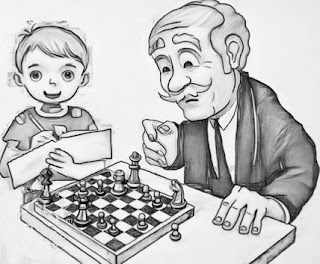Yesterday a cold front went past here and brought with it furnace igniting temperature, drizzling rain and wind that would blow the hair off a dog. It was a good day to look at some old games.
Back in the old days when all we had was chess books and no computers, my favorite books were tournament books and game collections. Alekhine, Tartakower, Reshevsky and Botvinnik were my favorites.
One book that I wore the cover off of was Botvinnik’s 100 Selected Games. They were games he played before becoming World Champion in 1948 and cover the period from his first big tournament which was the 1927 USSR Championship up to Groningen 1946.
I was flabbergasted to read one Amazon review in which the reviewer gave the book only one star! His reasons: 1) the bbok is in descriptive notation and 2) Stockfish punches holes in Botvinnik’s analysis.
In answer to the first point, anyone of at least below average intelligence can learn descriptive notation in a few minutes, so that should be no problem. As to the second point, today’s engines do punch holes (occasionally BIG ones) in old analysis. However, nobody except correspondence players are playing against engines.
Reading these old books can still be helpful, or if you are not looking to up your game, they can still be very enjoyable. After all, at one time Botvinnik was the best player in the world and so he must have known something about chess that we can lean from him. Studying classic games can be a valuable learning tool even if the annotators missed a lot of tactics (which is usually the area where engines point out their gaffs), but they help you understand strategy and recognize patterns.
Experts recommend that when you study these games you use an actual board, (unless, I suppose, the only place you play is on the Internet!) and try out moves and use the engine to show you what’s wrong (or maybe even right) with your move selection. Or, if you’re no longer looking to improve, just enjoy the games.
` The following is an instructive early game of Botvinnik’s that was played in the 1926 Leninggrad Championship.
A loss to Ilya Rabinovich ruined his chances of winning the tournament, but his tie for second was a good achievement.
His opponent was Abram Model (1896-1976), a Soviet Master and early coacj of Botvinnik, who had his title revoked by the Soviet chess authorities due to lack of good results.
He was born in Daugavpils, Latvia, then moved to St. Petersburg. He shared third place in the 1927 USSR Chess Championship and during World War II, he won the Championship of Leningrad in 1944.
What I found interesting about this game is that the Tactical Analysis with Stockfish assigns Botvinnik an Accuracy rating of only 49% which means that only half of his moves were what Stockfosh though was the best move. Even so, the moves he played were within mere hundredths of a Centipawn of the engine's top choices.
[Event "Leningrad ch"]
[Site "Leningrad URS"]
[Date "1926.??.??"]
[Round "?"]
[White "Abram Model"]
[Black "Mikhail Botvinnik"]
[Result "0-1"]
[ECO "D05"]
[Annotator "Stockfish 17.1"]
[PlyCount "54"]
[EventDate "1926.??.??"]
{D05: Colle-Zuckertort System} 1. Nf3 d5 2. b3 Nf6 3. Bb2 e6 4. e3 c5 5. d4 {
Model was an advocate of Nimzovich's 1.Nf3 and 2.b3, did not use Nimzovich's
Bb5, instead preferring this, the Zukertort System.} Nc6 6. Bd3 Bd6 7. O-O O-O
8. c4 {The opening has morphed from the rather innocuous setup to one that
more resembles an innocuous QP Opening. Against the usual 8.Nbd2 b;aclk has a
wide choice of playable moves.} b6 9. Ne5 Bb7 10. cxd5 exd5 11. Nd2 (11. Nxc6
Bxc6 12. dxc5 bxc5 {Black has Hanging Pawns which have a strategy of all their
own. Botvinnik was of the opinion that they give no advantage to either side.})
11... Qe7 12. Ndf3 Ne4 13. Rc1 Nb4 14. Bb1 f6 {An interesting move. Probably
few humans would play this and Stockfish, Dragon by Komodo, Lc0 and Fritz 19
all looked at ot for a fraction of a second before moving on to another move.
However, after playing 14...f6 thge evaluations of all engines remained dead
level.} 15. Nd3 {Black has the more active position, the position is pretty
boring as white has almost no attacking chances and finds himself on the
defensive...almost always a bad place to be.} Nxd3 16. Bxd3 Rfd8 17. Nh4 {
IThis move is hardly bad, but in view of what happens later retreating to d2
would have been safer.} g6 18. Qe2 Rac8 19. Qg4 Qd7 {This looks like it loses
a P and Model takes the bait. Engines want to play passivr stuff like 19...Ng4
or 19...c4} 20. Qxd7 {A reasonable option os to retreat the Q according to the
engines, but there is absolutely nothing wrong with the text.} Rxd7 21. Bxe4 {
Barking up the wrong tree...he is going afyer the offered P. 21.dxc5 qnd 22.
Rfd1 is rock solid.} dxe4 $17 22. dxc5 Bxc5 23. Bxf6 {[%mdl 8192] Model was an
excellent tactician, but he was apparently fixated on winning the P and did
not check the results of this capture which loses quickly. He would have had
some hope of saving himselgf after 23.Rfd1} Rf8 24. Bg5 {It doesn't matter
where the B retreat tp because the finish is the same/} Rd5 25. Bh6 Rfd8 {
The N has no retreat so hpw can white save it?} 26. Kh1 {He can'i.} (26. g3 Ba6
27. Rfe1 Bb4 {wins the exchange.}) (26. f3 Ba6 27. fxe4 Rh5) 26... g5 27. g3
gxh4 {White resigned.} 0-1



No comments:
Post a Comment